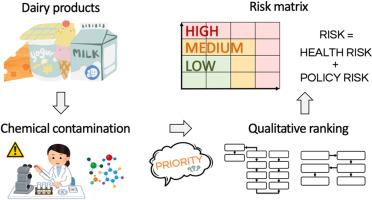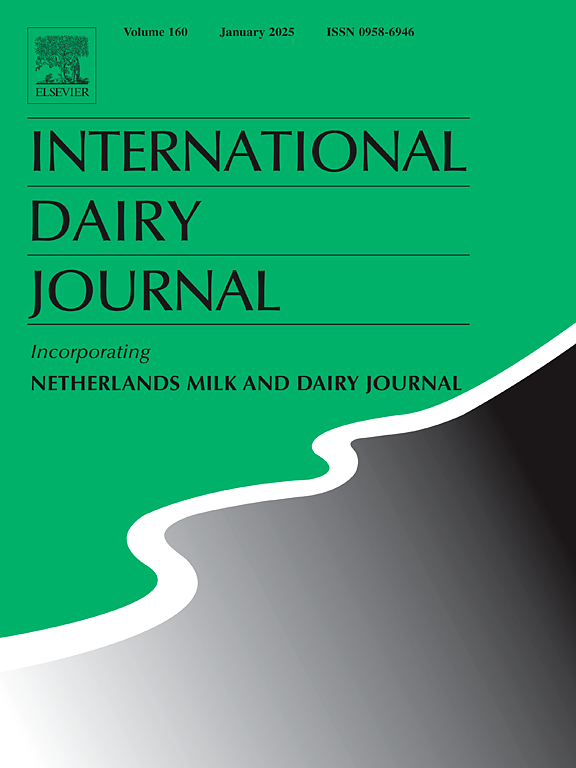A qualitative risk ranking approach of chemical contaminants for industrial needs: A case study on milk and dairy products
IF 3.4
3区 农林科学
Q2 FOOD SCIENCE & TECHNOLOGY
引用次数: 0
Abstract
Milk and dairy products are an important part of a healthy diet for many. Like all food products, they require constant vigilance for existing and emerging contaminants. Monitoring chemical contamination and managing the associated risks have become a top priority for dairy companies. Traditional risk ranking methods are mainly research-focused, requiring the understanding of complex numerical terms and extensive calculations. Therefore, in this study, a qualitative risk ranking approach was developed for companies to conduct a simple and quick prioritisation of the most significant hazards requiring investigation or interventions. To ensure product safety for health benefits and regulatory compliance, both health risk and policy risk were assessed following decision trees. Subsequently, chemicals were categorised into Tier 1 (RED), Tier 2 (AMBER), or Tier 3 (GREEN). Case studies demonstrate the practical applicability of the method through the analysis of literature data on three types of chemical hazards: established hazards (Aflatoxin M1), risk re-evaluation (Bisphenol A), and emerging contaminants (Per- and Polyfluorinated substances). The method provides a preliminary screening demanding a careful interpretation of results by users. Overall, the qualitative approach assists individual companies to use their own data and monitoring information to classify and prioritise chemical hazards.

工业需要化学污染物的定性风险排序方法:对牛奶和奶制品的个案研究
牛奶和奶制品是许多人健康饮食的重要组成部分。像所有食品一样,它们需要对现有的和新出现的污染物保持警惕。监测化学污染和管理相关风险已成为乳制品公司的首要任务。传统的风险排序方法以研究为主,需要理解复杂的数值术语和大量的计算。因此,在本研究中,为公司开发了一种定性风险排名方法,以便对需要调查或干预的最重大危害进行简单而快速的优先排序。为了确保产品对健康有益并符合法规,按照决策树对健康风险和政策风险进行了评估。随后,化学品被分类为1级(红色)、2级(琥珀色)或3级(绿色)。案例研究通过对三类化学危害的文献数据进行分析,证明了该方法的实际适用性:既定危害(黄曲霉毒素M1)、风险重新评估(双酚A)和新出现的污染物(全氟和多氟物质)。该方法提供了初步筛选,要求用户仔细解释结果。总体而言,定性方法帮助各个公司使用自己的数据和监测信息对化学品危害进行分类和优先排序。
本文章由计算机程序翻译,如有差异,请以英文原文为准。
求助全文
约1分钟内获得全文
求助全文
来源期刊

International Dairy Journal
工程技术-食品科技
CiteScore
6.50
自引率
9.70%
发文量
200
审稿时长
49 days
期刊介绍:
The International Dairy Journal publishes significant advancements in dairy science and technology in the form of research articles and critical reviews that are of relevance to the broader international dairy community. Within this scope, research on the science and technology of milk and dairy products and the nutritional and health aspects of dairy foods are included; the journal pays particular attention to applied research and its interface with the dairy industry.
The journal''s coverage includes the following, where directly applicable to dairy science and technology:
• Chemistry and physico-chemical properties of milk constituents
• Microbiology, food safety, enzymology, biotechnology
• Processing and engineering
• Emulsion science, food structure, and texture
• Raw material quality and effect on relevant products
• Flavour and off-flavour development
• Technological functionality and applications of dairy ingredients
• Sensory and consumer sciences
• Nutrition and substantiation of human health implications of milk components or dairy products
International Dairy Journal does not publish papers related to milk production, animal health and other aspects of on-farm milk production unless there is a clear relationship to dairy technology, human health or final product quality.
 求助内容:
求助内容: 应助结果提醒方式:
应助结果提醒方式:


